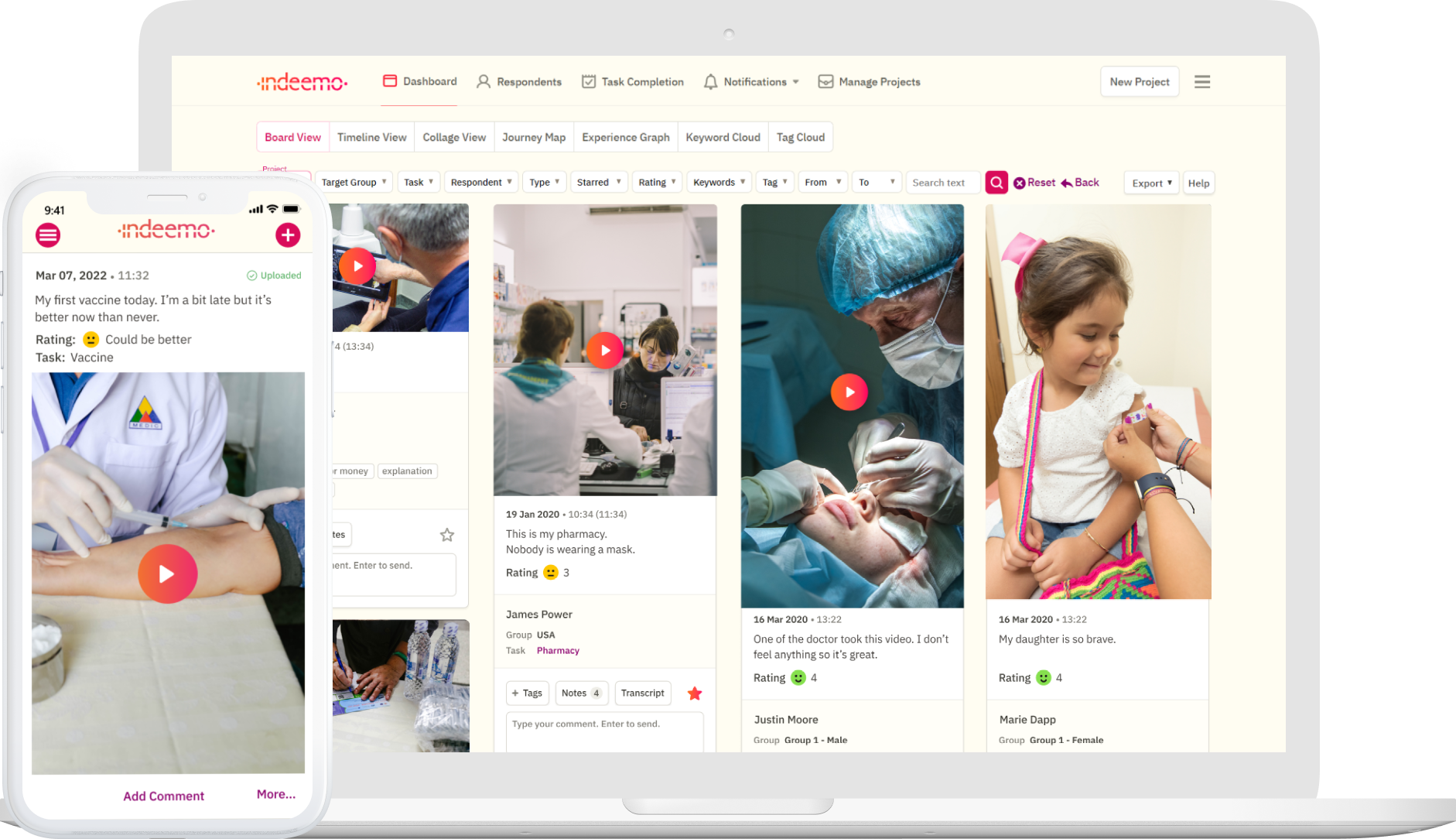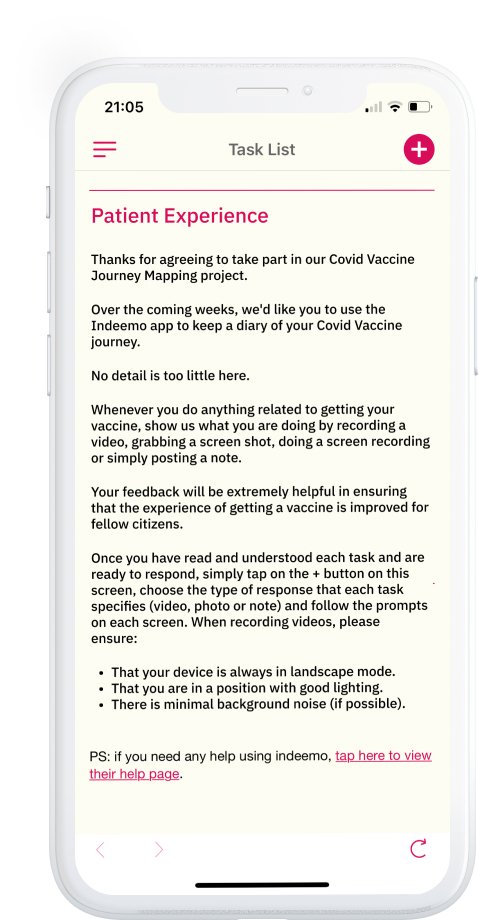Patient experience research is a key player in providing rich and contextual insights for improvements to the healthcare experience. Through qualitative research methods, research design techniques, and mobile technology, patient experience research is driven by empathy and in the moment data. This guide is there to help you drive patient-centred care by leveraging the opportunities resulting from patient experience research.
Indeemo User Journey Mapping Dashboard
What is Patient Experience?
Patient experience encompasses the entirety of a patient's interaction with a healthcare system. In a patient-centric organisation, the focus lies on identifying and improving areas where patient satisfaction may be lacking. At its core, patient experience revolves around giving priority to the patient's voice, building a repository of patient insights, and taking proactive measures to enhance patient outcomes based on these insights.
Experience research, particularly patient experience research, employs a range of qualitative methods to uncover previously unknown insights about the patient experience. In contrast to the quantitative nature of patient feedback surveys and satisfaction questionnaires, experience research increasingly relies on qualitative research methods. This shift is necessary due to the evolving complexity and non-linear nature of the patient journey.
The Advancement of Patient Experience in the Digital Era
The advent of digital health and telehealth has introduced new dimensions to the patient experience. Patients now have the convenience of scheduling appointments and even receiving consultations online, leading to an increase in interaction touchpoints. However, this expanded digital landscape also brings potential pain points and challenges that may lead to patient dissatisfaction with healthcare providers.
While certain healthcare systems excel in providing an exceptional patient experience, others struggle to maintain a patient-centric approach. It is important to address poor patient experience since it can result in lower patient retention rates. The goal of patient experience research is to equip decision-makers and healthcare professionals with contextual insights that can drive action and foster improved patient outcomes.
How to conduct Patient Experience Research
Patient experience research is undergoing a transformation, shifting from traditional feedback surveys to context-driven insights grounded in qualitative methods. This approach enables healthcare organisations to gain a deeper understanding of the patient experience and drive meaningful improvements. To conduct patient experience research that yields valuable insights, we present a step-by-step guide below.
Outline your patient experience research brief
Start by gathering and reviewing existing knowledge about your patients and their experiences. Utilise patient feedback data from surveys and other sources to shape your research objective. As the patient journey has become increasingly complex, aim to generate a comprehensive understanding of it with the help of your team. Ground your project brief in the insights you already possess, while also directing it towards new questions that arise from patient experience data.
Keep it Simple
In the quest to capture every aspect of the patient experience, it's important to focus on one area at a time. The complexity and variability of each patient's journey make it difficult to address everything simultaneously. By simplifying your approach and concentrating on a specific aspect, you can design patient experience research that yields quick, valuable, and in-depth insights. This also allows for ongoing review and iteration of your strategy, ensuring that patient experience research remains an integral part of your overall patient experience improvement efforts.
Further reading
What is Patient Journey Mapping?Patient Experience Research Design
The design of your research tasks should align with your overall research objective. Consider using qualitative techniques that leverage various media types, such as Video Diaries, Photovoice methods, and Ecological Momentary Assessment (EMA). For example, you can ask patients to record their experience upon entering a clinical setting and awaiting their medical appointment. With photovoice, participants can take photographs of touchpoints in their patient journey and provide accompanying explanations to provide rich contextual data.
To guide task design, create open-ended questions that encourage research participants to reflect on their experiences.
Build Themes
Qualitative data analysis requires a deep dive into transcripts of conversations between researchers and research participants. It involves drawing out emerging keywords from patient diaries. However, the value of insights that derive from qualitative data will always present you with new opportunities for improvements to patient experience. You may have segmented your research participants into patient personas. By outlining patient personas you will be able to uncover themes that reflect each patient type. In addition, you should begin to uncover insights at an emotional level. Through sentiment analysis you can build themes that reflect various paint points of the patient journey. Technology plays a strong role here. Increasingly, qualitative research tools are being adopted for patient experience research.
Qualitative Tools for Patient Experience Research
The ability to develop a rich understanding of the patient experience is becoming easier. Qualitative research methods are becoming the optimal research approach for empathy building. Healthcare organisations are leveraging the insights from qualitative research to drive patient experience improvements and design.
The growth of technological innovation to facilitate and support patient experience research puts the patient first, making patient-centred design and processes enhance the patient experience.
The Digitisation of the Patient Journey
The patient journey has become increasingly digitized, with electronic appointment booking and digital health elements becoming more prevalent. To gain a comprehensive understanding of the patient experience, researchers now utilize mobile screen recording capabilities. This allows for a deep dive into the digital touchpoints and interactions patients have with healthcare services. By observing the pain points patients encounter while trying to book appointments or navigate digital health platforms, researchers can extract valuable insights. Mobile screen recordings serve as a powerful tool to explore and analyze the digital aspects of the patient experience.
Patient Diaries are a key element for empathy building in experience research. Traditional approaches to diary studies depended on research participants documenting their behaviours and experiences using pen and paper. Today, diaries are integrated into the technological component of qualitative research. A patient diary allows the patient experience to be captured in real time and in the moment. With the use of photos and videos, a patient diary is immersed in context. Contextual insights from a diary study are captured via mobile technology and by doing so researchers are then able to pinpoint the exact areas of the healthcare system that patients express concern for. It plays a key role in our understanding of the patient journey.
Of course, these rich insights are a result of effective analysis of the qualitative data that research participants submit. For patient experience research, data analysis may take time. However, a central repository for all qualitative data can now be streamlined for quick and effective data analysis. Researcher dashboards are used to focus on various areas of the patient experience. As each research participant uploads their video diary of them arriving at a clinic and describing their experience, technology draws out specific keywords and automatically begins to transcribe the narration from the patient diary.
The Benefits of Patient Experience Research
First and foremost, many organisations have begun to put the human experience first. Customer experience is now driving improvements to service and product design. Employee and the onboarding experience aims to build a rich understanding of positive and negative areas of an employee journey. User research informs user-centred design. Ultimately, the goal for many organisations is to place those most important to their services and/or products front and centre during any decision making process.
The goal of patient experience research follows these principles. Patient experience research is important first, because it brings you closer to your patients. It forces you and your team to be patient-centric. Insights that emerge from patient experience research are more often than not rooted in qualitative data. Qualitative data will lead to new insights being uncovered. Insights will result in empathy. And empathy will put the patient first, making your organisation patient-centric.
The importance of patient experience research also relates to the dynamic nature of the patient journey. We have mentioned that the patient journey is becoming increasingly complex, with digital health and telehealth affording patients with new channels to healthcare services, and ultimately new patient experiences. Leveraging technology, patient experience research can help you identify numerous touchpoints of the patient journey. Patient journey mapping goes hand in hand with the patient experience, and often improvements to patient care are directed by the insights that are specific to core areas of the patient journey.
CASE STUDY
How a healthcare research consultant used pre-tasking for contactless research with at risk patients suffering from a long-term illness.
As an alternative to patient satisfaction surveys, the qualitative nature of patient experience research can put a spotlight on areas that are difficult to understand from a traditional quantitative approach. By conducting patient experience research to draw out contextual insights the results can often be leveraged for the design of a follow up and large scale study.
Patient retention is always a concern for healthcare organisations. Patients have more options relating to the services they can avail of. Patient experience research is increasingly adopted by qualitative health researchers to help improve areas of health services that will positively reflect on patient retention.
Indeemo, a patient experience research tool, harnesses the power of mobile technology to help you become a patient-centric organisation. Qualitative research and contextual insights drive patient experience through the Indeemo mobile app and researcher dashboard. The functionalities allow researchers to design flexible research strategies to help improve on patient experience.









